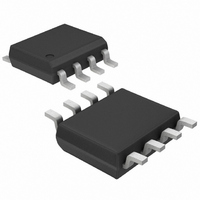MAX4040ESA+ Maxim Integrated Products, MAX4040ESA+ Datasheet - Page 12

MAX4040ESA+
Manufacturer Part Number
MAX4040ESA+
Description
IC OP AMP R-R SNGL 8-SOIC
Manufacturer
Maxim Integrated Products
Datasheet
1.MAX4040EUKT.pdf
(16 pages)
Specifications of MAX4040ESA+
Amplifier Type
General Purpose
Number Of Circuits
1
Output Type
Rail-to-Rail
Slew Rate
0.04 V/µs
Gain Bandwidth Product
90kHz
Current - Input Bias
2nA
Voltage - Input Offset
200µV
Current - Supply
14µA
Current - Output / Channel
2.5mA
Voltage - Supply, Single/dual (±)
2.4 V ~ 5.5 V, ±1.2 V ~ 2.75 V
Operating Temperature
-40°C ~ 85°C
Mounting Type
Surface Mount
Package / Case
8-SOIC (3.9mm Width)
Number Of Channels
1
Voltage Gain Db
94 dB
Common Mode Rejection Ratio (min)
70 dB
Input Offset Voltage
1.5 mV
Operating Supply Voltage
3 V, 5 V
Supply Current
0.02 mA
Maximum Power Dissipation
471 mW
Maximum Operating Temperature
+ 85 C
Mounting Style
SMD/SMT
Maximum Dual Supply Voltage
+/- 2.75 V
Minimum Operating Temperature
- 40 C
Lead Free Status / RoHS Status
Lead free / RoHS Compliant
-3db Bandwidth
-
Lead Free Status / Rohs Status
Details
Single/Dual/Quad, Low-Cost, SOT23,
Micropower, Rail-to-Rail I/O Op Amps
The MAX4040–MAX4044 contain special circuitry to
boost internal drive currents to the amplifier output
stage. This maximizes the output voltage range over
which the amplifiers are linear. In an open-loop com-
parator application, the excursion of the output voltage
is so close to the supply rails that the output stage tran-
sistors will saturate, causing the quiescent current to
increase from the normal 10µA. Typical quiescent cur-
rents increase to 35µA for the output saturating at V
and 28µA for the output at V
The MAX4040–MAX4044 are ideal for applications pow-
ered from a battery stack. Figure 9 shows an application
circuit in which the MAX4040 is used for monitoring the
current of a battery stack. In this circuit, a current load is
applied, and the voltage drop at the battery terminal is
sensed.
The voltage on the load side of the battery stack is
equal to the voltage at the emitter of Q1, due to the
feedback loop containing the op amp. As the load cur-
rent increases, the voltage drop across R1 and R2
increases. Thus, R2 provides a fraction of the load cur-
rent (set by the ratio of R1 and R2) that flows into the
emitter of the PNP transistor. Neglecting PNP base cur-
rent, this current flows into R3, producing a ground-ref-
erenced voltage proportional to the load current. Scale
R1 to give a voltage drop large enough in comparison
to V
The output voltage of the application can be calculated
using the following equation:
Figure 7. Propagation Delay vs. Input Overdrive
12
OS
______________________________________________________________________________________
of the op amp, in order to minimize errors.
10,000
as Ultra-Low-Power Current Monitors
1000
100
10
V
OUT
0
10
t
= [I
PD
Using the MAX4040–MAX4044
t
PD
+; V
+; V
20 30
LOAD
CC
CC
= +2.4V
= +5V
40 50 60 70 80 90
x (R1 / R2)] x R3
V
OD
t
PD
t
EE
PD
(mV)
-; V
-; V
.
CC
CC
= +5V
= +2.4V
100
CC
For a 1V output and a current load of 50mA, the choice
of resistors can be R1 = 2 , R2 = 100k , R3 = 1M .
The circuit consumes less power (but is more suscepti-
ble to noise) with higher values of R1, R2, and R3.
Figure 8. Hysteresis Comparator Circuit
Figure 9. Current Monitor for a Battery Stack
INPUT
V
OUTPUT
OH
V
OUT
R3
R2
V
IN
V
V
HI
LO
Q1
R1
R2
V
EE
I
LOAD
R1
R
V
V
HYST
CC
EE
MAX4040
MAX4040–
MAX4044
V
OUT
HYSTERESIS
V
V
OH
OL
V
V
CC
EE







